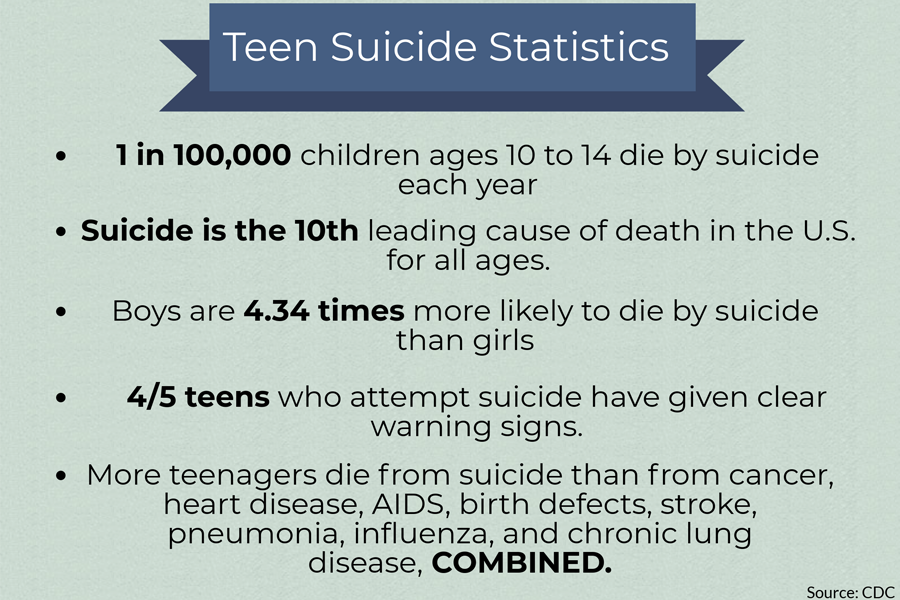Mental Health Needs More Attention
May 29, 2018
The end of 2017 brought great tragedy to MCPS as students opening their Snapchat “stories” found black screens with a single colored heart symbolizing the lost of a student to suicide. Walter Johnson HS and Walt Whitman HS (WWHS) faced the tragedy directly, but no school community escapes the growing issue.
RHS suffered the loss of Mark Guthrie (‘16) to suicide Feb. 12, 2017, which brought the community together as a tribute was made to him with his jersey number, “4” on the baseball backstop.
MCPS needs to make a fuller, more robust effort to recognize the signs of depression and suicidal thoughts, because the issue is so widespread, the more people are educated on the topic, the greater the effort can be made to save young lives.
Suicide is the 10th leading cause of death in the U.S., according to the Center for Disease Control and Prevention (CDC). Each year, more than 44,000 Americans kill themselves. This is an average of 21 suicides a day, five occuring within the ages of 15-19.
Statistics can be hard to comprehend because they come off as numbers, not people. When multiple teens in our county commit suicide in less than a week the numbers are no longer just statistics, they are a jarring, emotional reminder that there are countless teens who suffer from a variety of mental health disorders and never receive enough help and support.
Montgomery County is clearly hurting and before more tragedies fill our screens and hearts, it is time to have a serious discussion about ways to fund a concerted effort to educate all members of our community.
Suicide Contagion is “a group of suicides or suicide attempts, or both, that occur closer together in time and space than would normally be expected in a given community,” according to the CDC. Though this contagion continually occurs, there is not enough consistent prevention put in place in MCPS to prevent it. And what is currently available, is not widely known as seen in a recent survey by the Rampage.
After WWHS lost a member of their community, there was a day dedicated to mental health at school. While it is admirable that they responded with assistance, it is unfortunate that the county did not also respond with a more widespread, concerted effort to educate all members of this community. Often it seems that providing help for mental illness is provoked only by such a tragic incident. Resources should be more accessible to students, even in schools that weren’t directly affected by the losses.
Teens can find it hard to ask for help when depression and other mental illnesses are glorified in today’s society and on social media. Netflix’s original series, “13 Reasons Why” may not intend to glorify mental illness and suicide, but the public perceived the main character’s story as more of an adventure for entertainment than truly addressing the ways to prevent such tragedies.
Social media, on the other hand, is a platform on which teens feel pressure to perceive everything in their life as perfect. According to the American Psychiatric Association, there is a clear link between extensive time on social media and poor mental health conditions. Teens in 2018 live in a society filled with so much judgement which can cause them to put on a facade and pretend everything’s okay, and the second they “crack,” no one sees them the same.
Every year the issue is not approached in a serious way, the stigma around mental illnesses seems to get worse. Teens cannot admit that they are suffering when their elders experienced mental health help differently with more of a “don’t ask don’t tell” approach. The age gap decreases the likelihood that teens will express their feelings, which, when disregarded, have a detrimental impact.
As a community, it is time that students, parents, staff and admin demand change. Discrediting the stigma around mental health disorders is the first step. This can be done through more of an emphasis on disorders in education. Society must take the personal initiative to increase awareness whether it be asking doctors, counselors or teachers for resources needed. The more educated society is on mental health, the more prepared people will be when encountering those who struggle.
Students should be taught from a young age that people who have mental illnesses are not pariahs, and that mental illnesses can affect many different people in different ways. Providing more resources to prevent misconceptions and taking more time in school to make sure students who need help are getting it would be an appropriate first step.
If we want to ensure that it is no longer a routine to open social media and see that black screen, it is time for everyone to take the blindfold off from over their eyes and face the hard truth that mental health awareness is not just a talking point, but a necessity.




